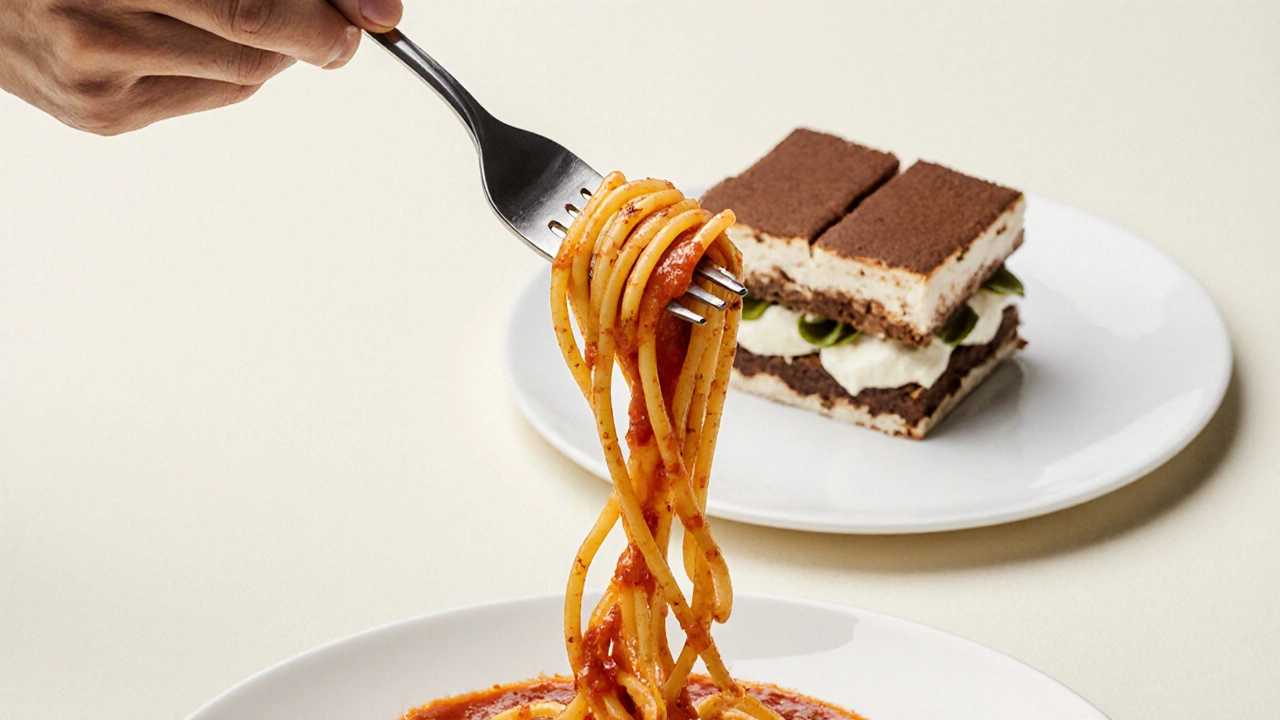Quick Takeaways
- Breaking pasta is seen as disrespectful in Italy because it alters texture and ignores centuries‑old etiquette.
- "Al dente" is more than a cooking term; it reflects a cultural commitment to balance of bite and sauce.
- Regional rules differ, but most Italians expect long strands (spaghetti, linguine) to stay whole.
- Travelers can avoid faux pas by using a fork‑and‑spoon technique, not by snapping the noodles.
- Understanding pasta etiquette also helps you appreciate desserts like tiramisu, which rely on the same respect for tradition.
When you sit down for a classic Italian meal, Italian pasta is a staple carbohydrate that embodies regional tradition, craftsmanship, and a strict etiquette around how it’s served and eaten. The moment you pick up a fork and start twirling, you’re participating in a ritual that has been refined for centuries. One of the most common breaches of that ritual-especially in the eyes of locals-is breaking the strands of long pasta. In many Italian households, snapping spaghetti in half is more than a bad table habit; it’s a cultural misstep that sparks raised eyebrows and, sometimes, outright reprimand.
The Historical Roots of Pasta Etiquette
Italy’s love affair with pasta dates back to the 13th‑century Arab influence on Sicily, but the codified etiquette emerged later, during the Renaissance when regional guilds regulated food preparation. The first written references to "proper" pasta appear in the 16th‑century cookbooks of Bartolomeo Scappi, the famed papal chef. Scappi warned against "cutting" long noodles, asserting that the length symbolized continuity and unity-values deeply embedded in Italian family life.
Over time, the guideline turned into a social rule: keep the noodle whole, cook it Al dente, and let the sauce cling naturally. Breaking the pasta was interpreted as a shortcut, a sign that the diner lacked respect for the dish’s heritage.
Why Length Matters: Texture, Sauce, and Symbolism
There are three practical reasons why Italians protect those long strands:
- Texture control: An unbroken strand has a consistent bite from tip to tail, delivering the intended Al dente firmness. A broken piece cooks faster, often turning mushy and losing that satisfying chew.
- Sauce adherence: Long noodles create a helix that grabs sauce along their entire length. When you snap the noodle, you shorten the surface area, and the sauce slides off, making the dish feel “light” and incomplete.
- Cultural symbolism: The uninterrupted length represents unity-think of a wedding rope or the long, winding roads of the Italian countryside. Breaking it unintentionally suggests a desire to “cut” that unity.
Regional Variations and Exceptions
Even within Italy, attitudes shift slightly from north to south. In Bologna, where Tagliatelle traditionally pairs with ragù, the noodle is broader and less prone to being broken on purpose. In the south, especially in Campania, the slim Spaghetti is the star, and breaking it is frowned upon most strongly.
That said, some housewives in rural Calabria do break spaghetti for quick soups, but they usually keep the practice hidden from guests. The rule remains: in any formal or restaurant setting, keep it intact.

Breaking Pasta vs. Traditional Unbroken Pasta
| Aspect | Traditional Unbroken Pasta | Broken Pasta |
|---|---|---|
| Texture | Consistent Al dente chew throughout | Variable; ends become softer faster |
| Sauce Retention | High-sauce climbs the helix | Low-sauce pools at bottom |
| Visual Presentation | Elegant, orderly strands | Messier, uneven lengths | ight>
| Cultural Acceptance | Widely praised, seen as respectful | Often seen as disrespectful |
Connecting Pasta Etiquette to Dessert Discipline: The Tiramisu Example
While pasta commands your fork, desserts like Tiramisu demand a similarly reverent approach. Tiramisu’s layers-espresso‑soaked ladyfingers, creamy mascarpone, cocoa dust-must stay intact. A hurried spoon that crushes the layers betrays the same lack of respect you’d show by snapping spaghetti.
Notice the parallel: both dishes rely on careful layering (in pasta, the layering of sauce; in tiramisu, the layering of flavors). When you treat each component with patience, you honor the craft.
Practical Tips for Travelers
- Use the classic fork‑and‑spoon twirl: rest the fork against the spoon, coil the pasta, then lift.
- If the noodle feels too long, gently fold it over the fork instead of breaking it.
- Watch how locals eat-if you’re at a family table, a quick glance can save you from an accidental snap.
- Order a “spaghetti al dente” without modifiers; chefs will know you expect the proper bite.
- When dessert arrives, fork the tiramisu gently; let the fork slide between layers rather than press down hard.

Common Myths Debunked
Myth 1: Breaking pasta makes it easier to eat for children.
Reality: Italian chefs design sauces and pasta shapes to be child‑friendly without altering the noodle. A proper twirl can be taught early.
Myth 2: Shorter noodles cook faster, saving time.
Reality: Professional kitchens time‑track every step; the few seconds saved are outweighed by the loss of texture and authenticity.
Myth 3: “It’s just a habit, not a rule.”
Reality: The habit is rooted in centuries‑old social codes that differentiate a respectful diner from an ignorant one.
Mini Checklist Before the Next Pasta Dish
- Check that the pasta is served whole.
- Confirm the sauce coats the noodle, not pools beneath.
- Twirl with fork and spoon, avoid forceful snapping.
- Respect the Al dente texture-no over‑cooking.
- When dessert appears, keep the same gentle handling for tiramisu.
Frequently Asked Questions
Is it ever acceptable to break spaghetti in Italy?
Only in very informal home settings where everyone is aware of the habit. In restaurants or when dining with strangers, it remains a breach of etiquette.
Why does "Al dente" matter more than cooking pasta until soft?
Al dente preserves the wheat’s structure, offers a balanced chew, and helps sauce cling better. Over‑cooked pasta becomes mushy, losing flavor and the intended mouthfeel.
Do other Italian foods have similar “no‑break” rules?
Yes. For example, breaking the crust of panettone before serving is frowned upon, and crushing the layered structure of tiramisu is considered disrespectful.
How can I politely join an Italian family dinner without offending anyone?
Observe first, follow the fork‑and‑spoon technique, keep the pasta whole, and compliment the chef on the "al dente" texture. A simple "Buon appetito!" goes a long way.
What should I do if I accidentally break a strand?
Apologize with a smile and continue eating. Most Italians will understand it was an honest mistake, especially if you’re otherwise respectful of the meal.
Understanding Italian pasta etiquette is more than a culinary tip; it’s a gateway to appreciating the deep cultural reverence Italians have for their food. By keeping noodles whole, honoring the al dente bite, and treating desserts like tiramisu with equal care, you become part of a culinary conversation that has spanned generations. So next time you’re in Italy, remember: let those strands dance, don’t snap them, and enjoy the meal the Italian way.